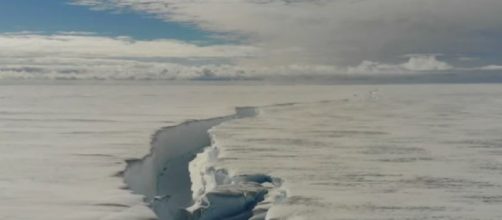The iceberg's length that broke off from the Brunt Ice Shelf in Antarctica was around 789 miles (1,270 km), and its thickness was 7054 feet (2,150 meters). It was located near a British Antarctic Survey BAS station. The BAS says available evidence does not suggest any significant role of climate change in this separation. Sky News mentions that cracks appeared nearly a decade ago, and its team was monitoring them regularly to ensure the safety of the research station and its people. Such cracks finally lead to separation, known as calving.
In this case, also, the cracks kept spreading with time.
In November 2020, a new chasm opened up, and by January, it kept expanding at a rate of slightly more than half a mile (one meter) every day. On February 26 morning, the crack widened further, and within a few hours, the iceberg separated. In July 2017, a massive one trillion-ton iceberg m Antarctica ice shelf broke off.
Iceberg separates in Antarctica
Sky News says the BAS Halley Research station is located in the Brunt Ice Shelf. Because of the cracks first noticed in 2010, the authorities decided to shift the facility in 2016. They moved it further inland. Since then, those who manage the setup have remained there only during the summer months. These are from November to March. The reason is problems associated with evacuation during the 24-hour darkness.
These are times when the temperature drops to around minus 50C and Travel is difficult. Presence on the site during Antarctic winter is not an easy task. Anyway, the team left the shelf in mid-February this year. In May last year, there were media reports that Antarctica and Greenland ice sheets' melting indicated our planet's health.
BAS will monitor the Antarctica situation
Sky News adds that the British Antarctic Survey believes the changes noticed in the ice shelf are natural. In their opinion, the breaking away of the iceberg does not have any link with climate change. In the Larsen C Ice Shelf case, huge icebergs had appeared, and that was different.
In Simon Garrod's words, director of operations at BAS - "This is a dynamic situation. Four years ago, we moved Halley Research Station inland to ensure that it would not be carried away when an iceberg eventually formed." He went on to add that the need of the hour is to maintain a close watch on further developments. That is necessary to check for any possible impact on the surrounding areas of the ice shelf. In March 2018, a secret colony of penguins surfaced in Antarctica.
The fate of the Antarctica iceberg was known
According to DW, scientists expected a huge chunk of ice to break away from the ice shelf for almost a decade. That was when the first cracks formed. Subsequently, the huge iceberg broke off only now.
Its size is like that of Greater London, and scientists are skeptical about the role of climate change. However, the fact remains that the event happened, and the massive block of ice is free and would keep moving with the winds and sea waves. The ice would also keep melting. That, in turn, could result in sea level rise and affect people in coastal areas. The events that led to the major split accelerated recently. Professor Dame Jane Francis, a British Antarctic Survey professor, says - "Our teams at BAS have been prepared for the calving of an iceberg from Brunt Ice Shelf for years." This Halley VI Research Station has to monitor the state of the vast floating ice shelf daily. While the team is away, GPS instruments take over the activity.
The iceberg is now on its own and could move away or run aground. It could remain close to the Brunt Ice Shelf. Anyway, the network of GPS instruments would provide information on how the iceberg is behaving.


